Connect With Us
Blog
Items filtered by date: August 2022
Many People Ignore the Signs of a Stress Fracture
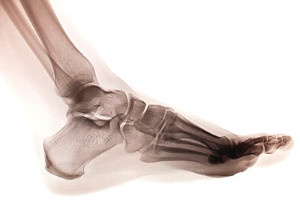
There are several bones in each foot, and a stress fracture occurs when there is a hairline break in one of the small bones. It often happens as a result of repetitive stress the feet endure from running or from frequently participating in jumping activities. The fractures are typically very small, despite how painful they can be. Many people choose to ignore the nagging pain in their foot, and it often becomes worse if it is not promptly treated. It may be a common injury among runners who increase their speed and frequency of running too soon, and this could gradually cause a stress fracture. This can be a result of a lack of strength and endurance from the muscles that cannot cope with added support that is needed when that activity increases. Additional reasons why stress fractures may occur include having an abnormal foot structure, wearing shoes that do not fit correctly, or having previous stress fractures. If you think you have endured this type of fracture, please speak with a podiatrist as quickly as possible who can properly treat this condition.
Activities where too much pressure is put on the feet can cause stress fractures. To learn more, contact Ronald Pieroni, DPM from Bolingbrook Foot and Ankle Center. Our doctor can provide the care you need to keep your pain free and on your feet.
Dealing with Stress Fractures of the Foot and Ankle
Stress fractures occur in the foot and ankle when muscles in these areas weaken from too much or too little use. The feet and ankles then lose support when walking or running from the impact of the ground. Since there is no protection, the bones receive the full impact of each step. Stress on the feet can cause cracks to form in the bones, thus creating stress fractures.
What Are Stress Fractures?
Stress fractures occur frequently in individuals whose daily activities cause great impact on the feet and ankles. Stress factors are most common among:
- Runners
- People affected with Osteoporosis
- Tennis or basketball players
- Gymnasts
- High impact workouts
Symptoms
Pain from the fractures occur in the area of the fractures and can be constant or intermittent. It will often cause sharp or dull pain with swelling and tenderness. Engaging in any kind of activity which involves high impact will aggravate pain.
If you have any questions please feel free to contact our office located in Bolingbrook, IL . We offer the newest diagnostic and treatment technologies for all your foot and ankle needs.
Are You Suffering From Nerve Damage?
Basic Tips on Preventing Running Injuries
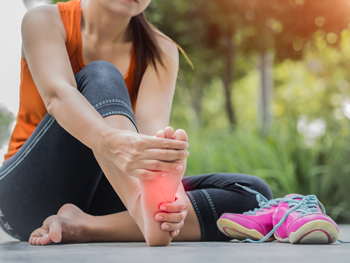
There are basic things you can do as a runner to prevent running injuries and maintain peak performance levels. Choosing the proper footwear should be your first step. When you shop for running shoes, take a few things into consideration, such as the type of surface you’ll be running on, your style of running, and your overall fitness goals. Have your feet measured every time you buy a new pair of running shoes to ensure a proper fit, and make sure you break in the shoes before training in them. Do regular strengthening exercises to build up muscles in your feet, which can help avoid injuries from occurring as well. Keep your feet dry while running to avoid blisters and athlete’s foot by wearing moisture-wicking socks. Your toenails should be trimmed so that they do not press against the tip of your shoes, but be mindful about trimming them too short (in order to avoid an ingrown toenail). After a run, consider massaging and icing your feet to reduce any swelling and help your muscles recover. A podiatrist can offer many more tips on footwear and preventing running injuries, as well as fit you for custom orthotics to address alignment/gait issues, and treat any foot or ankle pain you may have.
Sports related foot and ankle injuries require proper treatment before players can go back to their regular routines. For more information, contact Ronald Pieroni, DPM of Bolingbrook Foot and Ankle Center. Our doctor can provide the care you need to keep you pain-free and on your feet.
Sports Related Foot and Ankle Injuries
Foot and ankle injuries are a common occurrence when it comes to athletes of any sport. While many athletes dismiss the initial aches and pains, the truth is that ignoring potential foot and ankle injuries can lead to serious problems. As athletes continue to place pressure and strain the area further, a mild injury can turn into something as serious as a rupture and may lead to a permanent disability. There are many factors that contribute to sports related foot and ankle injuries, which include failure to warm up properly, not providing support or wearing bad footwear. Common injuries and conditions athletes face, including:
- Plantar Fasciitis
- Plantar Fasciosis
- Achilles Tendinitis
- Achilles Tendon Rupture
- Ankle Sprains
Sports related injuries are commonly treated using the RICE method. This includes rest, applying ice to the injured area, compression and elevating the ankle. More serious sprains and injuries may require surgery, which could include arthroscopic and reconstructive surgery. Rehabilitation and therapy may also be required in order to get any recovering athlete to become fully functional again. Any unusual aches and pains an athlete sustains must be evaluated by a licensed, reputable medical professional.
If you have any questions please feel free to contact our office located in Bolingbrook, IL . We offer the newest diagnostic and treatment technologies for all your foot and ankle needs.
How Bad Are High Heels for My Feet?
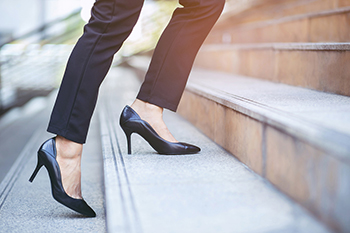
Research has shown that one third of women who frequently wear high heels have fallen while wearing them. High heels may be the cause of foot problems in women, and some may suffer permanent damage. The foot condition that is called hammertoe may develop, and this may happen when the toes do not have adequate room to move freely in. Additionally, many women can get ingrown toenails, which can occur when the toe rubs against the top of the shoe. The foot can be forced into an unnatural shape when the heels are two inches or higher, and this may alter the foot structure. The foot may slide forward, causing the weight of the body to redistribute, and the body may tilt forward. This can wreak havoc on the overall body, and the posture may be negatively affected. There are many women who enjoy wearing high heels, and there are shoes that can be worn that are safer on the feet and body. These can include choosing shoes that have a lower heel, wearing soft insoles inside the shoe, and alternating shoes worn from one day to the next. If you would like additional information about how high heels can affect the feet, please consult with a podiatrist who can answer any questions you may have.
High heels have a history of causing foot and ankle problems. If you have any concerns about your feet or ankles, contact Ronald Pieroni, DPM from Bolingbrook Foot and Ankle Center. Our doctor can provide the care you need to keep you pain-free and on your feet.
Effects of High Heels on the Feet
High heels are popular shoes among women because of their many styles and societal appeal. Despite this, high heels can still cause many health problems if worn too frequently.
Which Parts of My Body Will Be Affected by High Heels?
- Ankle Joints
- Achilles Tendon – May shorten and stiffen with prolonged wear
- Balls of the Feet
- Knees – Heels cause the knees to bend constantly, creating stress on them
- Back – They decrease the spine’s ability to absorb shock, which may lead to back pain. The vertebrae of the lower back may compress.
What Kinds of Foot Problems Can Develop from Wearing High Heels?
- Corns
- Calluses
- Hammertoe
- Bunions
- Morton’s Neuroma
- Plantar Fasciitis
How Can I Still Wear High Heels and Maintain Foot Health?
If you want to wear high heeled shoes, make sure that you are not wearing them every day, as this will help prevent long term physical problems. Try wearing thicker heels as opposed to stilettos to distribute weight more evenly across the feet. Always make sure you are wearing the proper shoes for the right occasion, such as sneakers for exercising. If you walk to work, try carrying your heels with you and changing into them once you arrive at work. Adding inserts to your heels can help cushion your feet and absorb shock. Full foot inserts or metatarsal pads are available.
If you have any questions please feel free to contact our office located in Bolingbrook, IL . We offer the newest diagnostic and treatment technologies for all your foot and ankle needs.
Changes to Your Feet as You Age
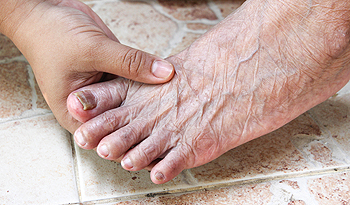
As people age, the body undergoes numerous changes, and changes to the feet are no exception. First, the skin becomes thinner, and you may notice joint pain you never had before from simple wear and tear. In addition, the muscles become weaker and less resilient. All this adds up to not being able to do many of the things that you used to do, or doing them more slowly and for shorter periods of time. Added to simply aging, certain conditions such as neuropathy, circulatory issues, and swelling of the feet (edema) may bring additional pain and increase the risk of injury or falling. The bones also begin to lose density, adding to the risk of fractures, especially in post-menopausal women. The fat pads in the heels and soles of the feet diminish, which may lead to such painful conditions as plantar fasciitis. Arthritis, an inflammation of the joints, may develop, causing more pain. Ways to stave off some of the effects of aging feet include finding footwear that fits properly and provides extra cushioning. Also, it is thought that foot and toe stretches help to keep the blood circulating and prevent swelling. Keeping your feet clean, dry, and moisturized can help you avoid infections. And watching your weight is important, as extra weight increases the load your feet have to support each time you take a step. For more information on taking care of your feet during your older years, please consult a podiatrist.
Proper foot care is something many older adults forget to consider. If you have any concerns about your feet and ankles, contact Ronald Pieroni, DPM from Bolingbrook Foot and Ankle Center. Our doctor can provide the care you need to keep you pain-free and on your feet.
The Elderly and Their Feet
As we age we start to notice many changes in our body, but the elder population may not notice them right away. Medical conditions may prevent the elderly to take notice of their foot health right away. Poor vision is a lead contributor to not taking action for the elderly.
Common Conditions
- Neuropathy – can reduce feeling in the feet and can hide many life-threatening medical conditions.
- Reduced flexibility – prevents the ability of proper toenail trimming, and foot cleaning. If left untreated, it may lead to further medical issues.
- Foot sores – amongst the older population can be serious before they are discovered. Some of the problematic conditions they may face are:
- Gouging toenails affecting nearby toe
- Shoes that don’t fit properly
- Pressure sores
- Loss of circulation in legs & feet
- Edema & swelling of feet and ankles
Susceptible Infections
Diabetes and poor circulation can cause general loss of sensitivity over the years, turning a simple cut into a serious issue.
If you have any questions please feel free to contact our office located in Bolingbrook, IL . We offer the newest diagnostic and treatment technologies for all your foot and ankle needs.
Parts of the Foot Affected by Athlete’s Foot
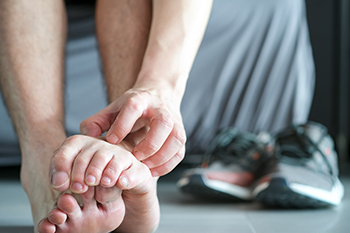
A common foot infection is known as athlete’s foot. Its medical term is tinea pedis, and it is caused by a fungus. This type of fungus lives and thrives in warm and moist environments, including public shower room floors, and locker rooms. It is beneficial to wear appropriate shoes while in these types of areas, and to refrain from sharing socks, shoes, and towels. Common symptoms that are associated with athlete’s foot consist of itchy feet, the soles may turn red and become dry, and the skin may crack between the toes. A proper diagnosis can include having a podiatrist examine the feet, often followed by having a sample taken of infected skin. Many times medication is prescribed that can provide mild relief for the itching and scaling. Effective prevention methods include washing and drying the feet daily, followed by wearing a clean pair of socks, and alternating the shoes that are worn. Additionally, it is beneficial to wear shoes that are made of breathable materials and to avoid wearing shoes made of vinyl. If you have questions about relief for athlete’s foot, please confer with a podiatrist who can determine what the best course of treatment is for you.
Athlete’s Foot
Athlete’s foot is often an uncomfortable condition to experience. Thankfully, podiatrists specialize in treating athlete’s foot and offer the best treatment options. If you have any questions about athlete’s foot, consult with Ronald Pieroni, DPM from Bolingbrook Foot and Ankle Center. Our doctor will assess your condition and provide you with quality treatment.
What Is Athlete’s Foot?
Tinea pedis, more commonly known as athlete’s foot, is a non-serious and common fungal infection of the foot. Athlete’s foot is contagious and can be contracted by touching someone who has it or infected surfaces. The most common places contaminated by it are public showers, locker rooms, and swimming pools. Once contracted, it grows on feet that are left inside moist, dark, and warm shoes and socks.
Prevention
The most effective ways to prevent athlete’s foot include:
- Thoroughly washing and drying feet
- Avoid going barefoot in locker rooms and public showers
- Using shower shoes in public showers
- Wearing socks that allow the feet to breathe
- Changing socks and shoes frequently if you sweat a lot
Symptoms
Athlete’s foot initially occurs as a rash between the toes. However, if left undiagnosed, it can spread to the sides and bottom of the feet, toenails, and if touched by hand, the hands themselves. Symptoms include:
- Redness
- Burning
- Itching
- Scaly and peeling skin
Diagnosis and Treatment
Diagnosis is quick and easy. Skin samples will be taken and either viewed under a microscope or sent to a lab for testing. Sometimes, a podiatrist can diagnose it based on simply looking at it. Once confirmed, treatment options include oral and topical antifungal medications.
If you have any questions, please feel free to contact our office located in Bolingbrook, IL . We offer the newest diagnostic and treatment technologies for all your foot care needs.

